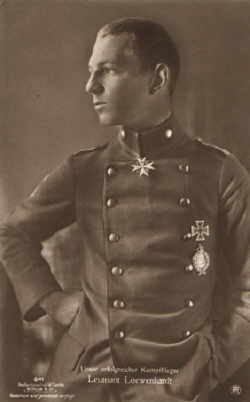Erich Löwenhardt
Great Ace of Jasta 10
By Stephen Sherman, Aug. 2001. Updated April 15, 2012.
Flying a bright yellow Fokker D VII in mid 1918, Germany's third ranking ace scored 21 of his 54 victories in just six weeks, the last of his life.
Born in Breslau in 1897, Löwenhardt enrolled in the Lichtfelder Cadet School when the war broke out. He was posted to the 141st Infantry as a standard bearer and went to the Eastern Front. Wounded near Lodz early on, he stayed with his unit through the battle of Tannenberg and for bravery there was promoted to Leutnant. In October 1914 he was given command of ski troops that had fought so well in the Carpathian campaign.
He earned the Iron Cross 1st Class for gallantry and leadership, and by June 1915 he transferred to Austro-German Alpine Corps for service on the Italian front. During this campaign, he sickened and was deemed unfit for further military service.
Undeterred, the young Leutnant recuperated for five months and then passed the physical exam to join the Imperial Air Service. After a period as an observer, he became a pilot in March 1917 and rapidly advanced to Jasta 10 in July.
In Albatros and Pfalz biplanes, he had destroyed 18 enemy aircraft and rose to command Jasta 10 by May 2, 1918. A methodical, rather than impetuous, fighter, he included eight balloons among his total in that period.
In early November 1917, he was flying over Saint-Eloi when some mobile anti-aircraft guns began bracketing him with gunfire. One shell (which didn't explode) tore through his left wing tip and his Albatros went into a spin. Barely 15 meters off the ground, he regained a measure of control and managed to hit the ground wheels-first. Nonetheless, his machine bounced and twice turned over completely. The Albatros was a wreck and Löwenhardt walked away, badly shaken but not seriously injured.
Löwenhardt's Jasta 10 never converted to Fokker Dr I triplanes; as the only Staffel of JG I still flying the obsolete Albatros biplanes, it was the ideal unit to receive the first Fokker D.VII biplanes in early May 1918. On May 9 Löwenhardt, in his new biplane, outraced the triplanes of Jasta 11 to down an SE5a over Hamel. By the end of the month, he had pushed his total to 24 (including a DH4, a Camel, and another balloon) and earned the coveted Pour le Mérite, the "Blue Max."
In June and July, Löwenhardt's score mounted, as he and Ernst Udet strove for the honor of being the top ace of JG I. He and Lothar von Richthofen often flew together; the long war had decimated the Geschwader's ranks of skilled pilots and the few veteran fliers had to rely on each other. Erich and Lothar found a rapport in the air and communicated spendidly with each other. On August 8th, he claimed five Allied planes, among them his 50th aerial victory, a milestone that --- among WWI German pilots ---only he, Manfred von Richthofen, and Ernst Udet would achieve.
On August 10, Löwenhardt, flying with a badly swollen sprained ankle, took off about 11 AM, leading a dozen planes from Jastas 10 and 11, including many neophytes. They spotted a flight of British aircraft over Chaulnes a little after noon; when one of the British planes strayed, Löwenhardt quickly nosed down to attack the isolated scout. Several of the new pilots unecessarily followed in his wake. Lothar von Richthofen described the scene in his article, My Last Time at the Front
Löwenhardt in his bright yellow machine was right behind the Englishman. I saw right away that everyone else was superfluous. But four or five of them didn't realize this, and were flying right behind Löwenhardt. Then, all of a sudden, I see the Englishman dive straight down, a trail of smoke behind him. ... But what's that? Löwenhardt is no longer flying behind the downed Englishman --- just a chaotic mess of thousands of splinters.
Ltn. Alfred Wentz of Jasta 11 and Löwenhardt had collided. As Wentz described it, Löwenhardt's wheels struck his upper right wing. His airplane out of control, Wentz hit the silk and landed safely. Löwenhardt also took to his chute, but it didn't open and the great ace plummeted to his death. He had 54 aerial victories to his credit, putting him alongside the great ones of WWI aviation: Richthofen, Fonck, Bishop, Mannock, Udet, Guynemer, Boelcke, and Ball.
Sources:
- Fokker D VII Aces of World War 1 (Part 1) (Osprey Aircraft of the Aces 53), by Norman Franks, John Weal (Illustrator), Greg Vanwyngarden (Illustrator)
- Fokker D.VII at the NASM
- Rand McNally Encyclopedia of Military Aircraft, 1914-1980, by Enzo Angelucci, The Military Press, New York, 1983
- The Aerodrome
- The Fokker D.VII File - an excellent site by H. Vossers, with detailed comments on Fokker D.VII's in other countries after WWI.

